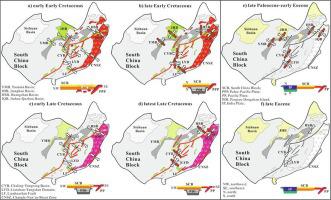Journal of Asian Earth Sciences ( IF 3 ) Pub Date : 2021-09-17 , DOI: 10.1016/j.jseaes.2021.104951 Xianbing Xu 1 , Chenghua Liang 1 , Yadong Xu 1

|
Cretaceous tectonic events and Cenozoic geodynamics of the central South China Block are still under debate. A long-term extensional regime or two extension-contraction tectonic cycles were proposed for the Cretaceous tectonic evolution. While Cenozoic geodynamics of the central South China Block were ascribed to the Pacific subduction or the far field effect of the India-Asia collision. Kinematic analysis of fault-slip data were carried out for the Cretaceous to Paleogene Chaling-Yongxing Basin and the Lianshan-Yangshan Domain in the Nanling Tectonic Belt. Kinematic analysis of fault-slip data (409 groups of faults and striations) reveal four Cretaceous tectonic events and two Paleogene tectonic events. i) The early Early Cretaceous extensional regime is represented by a NW-SE horizontal minimum principal stress and a vertical maximum principal stress, which generated NE-striking boundary normal faults of Early Cretaceous basins. ii) The late Early Cretaceous strike-slip regime is characterized by a N-S horizontal maximum principal stress and a E-W horizontal minimum principal stress, which led to tectonic inversion of Early Cretaceous extensional basins and nearly N-S-striking folding of the Lower Cretaceous. iii) The early Late Cretaceous extensional regime is represented by a NW-SE horizontal minimum principal stress and a vertical maximum principal stress, which activated the NE-striking boundary normal faults of Late Cretaceous basins. And iv) the latest Late Cretaceous strike-slip regime is characterized by NW-SE horizontal maximum principal stress and a NE-SW horizontal minimum principal stress, which led to tectonic inversion of Late Cretaceous extensional basins and NNE-striking folding of the Upper Cretaceous. Orientations of maximum or minimum principal stresses imply that two extension-contraction tectonic cycles during the Cretaceous resulted from the Paleo-Pacific subduction. Two Paleogene tectonic events are v) the strike-slip regime characterized by NE-SW horizontal maximum principal stress and a NW-SE horizontal minimum principal stress, and vi) the subsequent extensional regime represented by a NE-SW minimum principal stress and a vertical maximum principal stress. The former generated NW-striking reverse faults and reactivated strike-slipping of NE- and NW-striking conjugate faults whereas the latter formed NW-striking normal faults in the Lower Paleogene clastic rocks. Orientations of maximum or minimum principal stresses indicate that two Paleogene tectonic events in the central South China Block were attributed to the far field effect of the India-Asia collision and subsequent stress relief.
中文翻译:

中南地块南岭构造带及白垩系至古近系构造演化断层滑动数据运动学分析
华南地块中部的白垩纪构造事件和新生代地球动力学仍在争论中。提出了白垩纪构造演化的长期伸展状态或两个伸展-收缩构造旋回。而华南地块中部新生代地球动力学则归因于太平洋俯冲或印亚碰撞远场效应。对南岭构造带白垩系至古近系茶陵-永兴盆地和连山-阳山域断层滑动数据进行运动学分析。断层滑动数据(409 组断层和条纹)的运动学分析揭示了四个白垩纪构造事件和两个古近纪构造事件。i) 早白垩世早白垩世伸展状态以 NW-SE 水平最小主应力和垂直最大主应力为代表,产生了早白垩世盆地 NE 走向的边界正断层。ii) 早白垩世晚期走滑体制以南北向最大主应力和东西向最小主应力为特征,导致早白垩世伸展盆地构造反转,下白垩世近南北走向褶皱。iii) 晚白垩世早期伸展状态以NW-SE 水平最小主应力和垂直最大主应力为代表,激活了晚白垩世盆地NE 走向的边界正断层。iv) 晚白垩世最新走滑体制以 NW-SE 水平最大主应力和 NE-SW 水平最小主应力为特征, 导致晚白垩世伸展盆地构造反转和上白垩统 NNE 走向的褶皱. 最大或最小主应力的方向意味着白垩纪期间的两个伸展-收缩构造旋回是由古太平洋俯冲作用引起的。两个古近系构造事件是 v) 以 NE-SW 水平最大主应力和 NW-SE 水平最小主应力为特征的走滑状态,以及 vi) 以 NE-SW 最小主应力和垂直方向为特征的后续伸展状态最大主应力。前者在下古近系碎屑岩中形成了 NW 走向的逆断层并重新激活了 NE 和 NW 走向的共轭断层的走滑,而后者形成了 NW 走向的正断层。最大或最小主应力方向表明华南地块中部的两次古近系构造事件归因于印亚碰撞的远场效应和随后的应力释放。



























 京公网安备 11010802027423号
京公网安备 11010802027423号